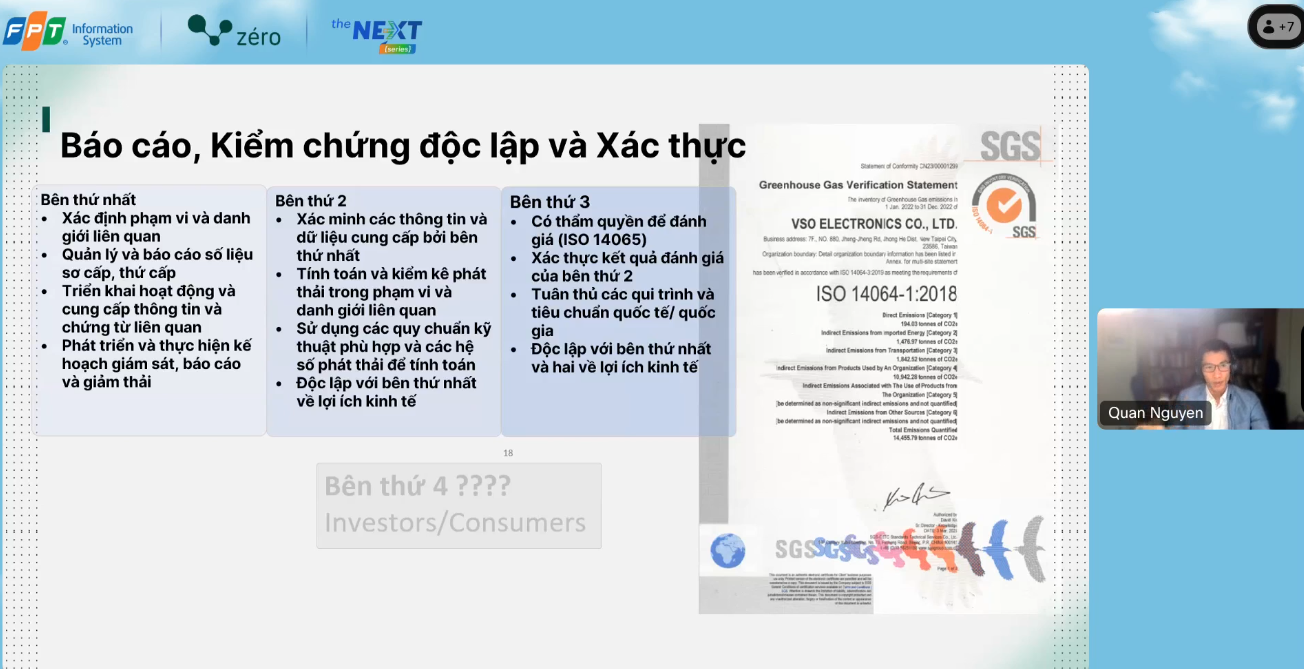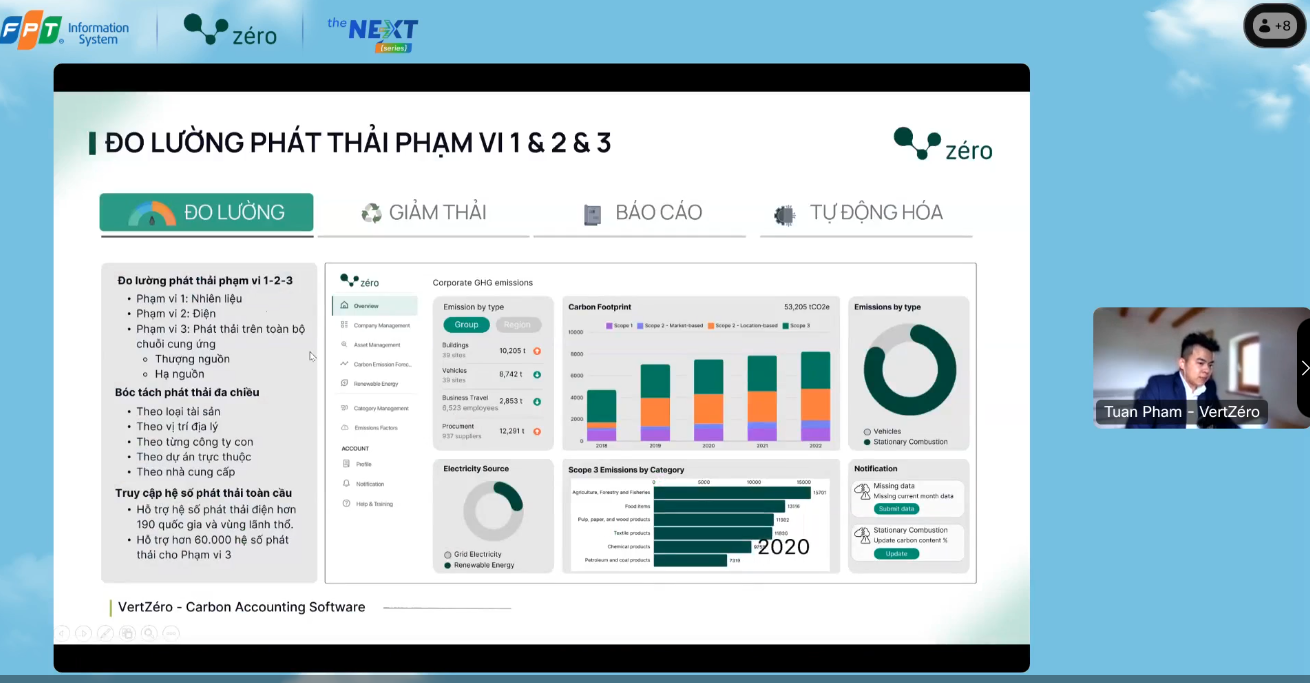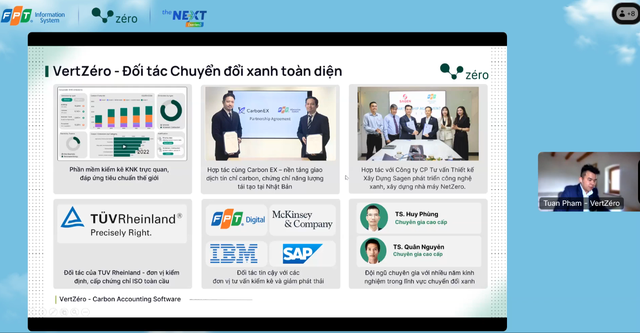
The workshop was attended by leading technology experts on ESG from FPT IS: Mr. Quan Nguyen – PhD in Environmental Science with over 10 years of experience in carbon credit trading, waste management, and a member of GHG Protocol; Mr. Tuan Pham – Master of Business Administration, PhD researcher in Climate Finance in Europe, Product Director of VertZéro. The event attracted the participation of nearly 500 business representatives nationwide.
In Vietnam, since the beginning of 2023, about 1,920 listed emission facilities have started to conduct periodic greenhouse gas emission inventories. Starting from 2025, thousands of enterprises will be required to conduct greenhouse gas emission inventories as required by the Ministry of Natural Resources and Environment. As a party to the Paris Agreement, Vietnam has committed to mitigating greenhouse gas emissions with the target of reducing 15.8% (by domestic resources) and 43.5% (with international support) in 2030 compared to the business-as-usual scenario.
According to Dr. Quan Nguyen, PhD in Environmental Science with over 10 years of experience in carbon credit trading, waste management, and a member of the GHG Protocol, in order to conduct a greenhouse gas inventory, enterprises need to comply with many international standards such as: ISO 14064 series of standards – Total emissions, greenhouse gas emission reductions, carbon storage for organizations, enterprises, and projects; ISO 14067 – Product life cycle greenhouse gas assessment; ISO 14068 – Management of climate change, zero-carbon transition – Carbon neutrality; GHG Protocols; Corporate/Organization Standards; Corporate Value Chain Standards (Scope 3) – Indirect Emissions….

Mr. Quan pointed out the ways to define the organizational boundaries.
In which, ISO 14064-1:2018 is the most important content belonging to the ISO 14001 Standard System related to greenhouse gas management activities. The ISO 14064-1 standard sets out the requirements for the design, development, management, reporting, and verification of an organization’s greenhouse gas inventory; evaluation of baseline emissions and annual emissions; determination of emission sources and carbon sinks; primary data from the organization’s activities.
Mr. Quan said that applying the ISO 14064-1:2018 standard brings many benefits to enterprises such as: Enhancing reputation (demonstrating commitment to environmental protection, building a green image, and being responsible to the community); Improving management (guiding enterprises in identifying, monitoring, and reporting greenhouse gas emissions); Reducing costs (controlling and cutting emissions); Increasing competitive advantage (meeting the greenhouse gas emission requirements of customers and partners).
To conduct a greenhouse gas inventory, Mr. Quan emphasized that businesses should not do it alone. Because this is a process that requires high accuracy, transparency, and reliability. Therefore, businesses need to coordinate with three parties: (1) Defining the relevant scope and boundaries, (2) Verifying the information and data provided by the first party, (3) Having the competence to evaluate (ISO 14065).

Mr. Quan emphasized that the greenhouse gas inventory process requires the participation of three parties.
Sharing the same view on this issue, Mr. Tuan Pham – Master of Business Administration, PhD researcher in Climate Finance in Europe, Product Director of VertZéro, said that the greenhouse gas inventory process requires 5 steps: (1) Defining organizational boundaries and emission sources; (2) Collecting activity data, emission factors; (3) Calculating the amount of emissions for each source (fuel, electricity, procurement…); (4) Determining emission reduction targets; (5) Reporting results, setting emission reduction targets.
However, Mr. Tuan also said that many Vietnamese enterprises are facing challenges in greenhouse gas inventory such as: Time-consuming data collection; Not being equipped with enough knowledge about complex standards and regulations, Environmental data of enterprises is not yet available….
“In that context, FPT IS is currently one of the first units to provide greenhouse gas inventory solutions in Vietnam – VertZéro. The digital solution comprehensively digitizes the process of environmental data collection, calculation, management, greenhouse gas reporting, meeting global emission reporting frameworks, eliminating greenhouse gases such as ISO 14064-1, GHG Protocol, and other standards,” said Mr. Tuan.

VertZéro helps organizations measure, reduce emissions, create reports and automate the greenhouse gas inventory process.
VertZéro helps businesses to define boundaries, and measure emission levels according to scopes 1,2,3; separate multi-dimensional emissions, and access global emission factors. From there, businesses have a basis to set emission reduction targets (over time, by scope, according to government regulations…) and monitor emissions in practice. Once the information is transparent, the solution helps businesses create greenhouse gas inventory reports in compliance with regulations of: Vietnamese government (Decree 06/2022/ND-CP, ISO14064-1:2011), International (GHG Protocol, IPCC, EPA, ISO 14064-1:2018), Europe (CBAM). Thus, with VertZéro, organizations hold the key to automating the greenhouse gas inventory process from: Complying with regulations and standards, updating emission factors, connecting data from suppliers, and automatically generating reports.
VertZéro is being deployed for FPT Software, aiming to help the company proactively inventory greenhouse gases according to 3 scopes, connect and synchronize data from 30 countries, build standard emission factors, and customize each region. The deployment process is designed to meet global standards frameworks, closely following the requirements of sustainable development in the global technology supply chain.

VertZéro is supporting many enterprises on their green transformation journey.





































